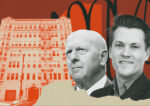Trending
Retail market keeps softening
Miami-Dade, Broward and Palm Beach counties have not seen massive foreclosures of commercial properties yet. But lower rents, rising vacancies and a growing sense of uncertainty suggest that foreclosures may be on the way for area retailers.
Terry Salzman, senior vice president of SRS Real Estate Partners, said 18 months from now banks and mortgage holders may start seizing commercial properties as landowners find it harder to obtain refinancing. “Selective properties are in trouble,” he said.
Vacancy in the South Beach market alone is forecast to reach 8.1 percent this year, up from 6.7 percent at the end of last year. It was 5.1 percent at the end of 2007.
Observers figure there’s more to come, especially in Broward County, where the market “has not hit bottom yet,” Salzman said.
Palm Beach County is also hurting, according to H. Alan Welles of H. Alan Welles Commercial Real Estate. He says he just transacted a deal for a client who wanted $100 per square foot for a free standing store. That client had to take $77 a square foot.
Things are particularly bad in the city of Lake Worth, Welles said. “A lot of people want to get out of Lake Worth right now,” he said, emphasizing that city’s high utility costs.
In other areas, like West Palm Beach, there “are decent absorption deals” though many landlords are offering lower rents with shorter lease deals in the hopes that the market will turn around, Welles said.
Salzman said the economic pain is evenly felt in Broward but is particularly painful in Pembroke Pines, where two strip malls have just lost their anchor tenants. Bal Harbour Square, a 180,000 square foot facility in Fort Lauderdale, was also hit hard with a Circuit City, a Linens N’ Things and a CompUSA closing.
However, most of Fort Lauderdale is doing pretty well. “Las Olas is very well occupied,” Salzman said.
Also hanging on are the high-demand areas of Miami-Dade County like South Beach, the Design District, Brickell, Coral Gables and Aventura. “There haven’t been any sales adjustments [in those areas],” said Lyle Stern of Koniver Stern Group. “Walk down Lincoln Road and try to find a place to park.”
Lincoln Road, a pedestrian shopping and restaurant area in South Beach that stretches several city blocks, only has two vacancies, Stern said, and retail rents have not dropped below $120 per square foot. But Marcus & Millichap reports that Miami-Dade asking rents could fall 3.7 percent to $23.70 a square foot through 2009, with effective rents dipping 4.1 percent to $20.84 per square foot.
Recent vacancies in Aventura have actually created excitement from retailers wishing to enter the Northeast Miami-Dade municipality, which is home to Aventura Mall, a shopping center with 280 restaurants and shops. “The Aventura submarket is probably one of the strongest submarkets in South Florida,” said Salzman of SRS Real Estate Partners.
That excitement has even spilled over to Gulfstream Park in Hallandale Beach, just north of Aventura, where Magnum Financial is building a retail complex next to the horserace track and casino. In spite of the market slow down, Magnum is inking deals thanks to a “very long leasing campaign,” Salzman said.
Although the Shops at Midtown Miami was home to Circuit City and Linens ‘N Things, owner Diversified Development has “made announcements of new tenants” that include a quick service restaurant and a “more casual fine dining restaurant.”
While corporate retailers struggle to adapt to the new economy, lower rents are enticing new entrepreneurs to take over vacant spaces, said Welles of Palm Beach County.
But Salzman cautions that small businesses will not cure the retail rental slump. “The local spaces are being looked at by local entrepreneurs,” he said. “But they will not refill the anchor tenant vacancies available.”
Still Salzman is optimistic that the retail market will turn around in South Florida.
“It always gets better,” he said. “South Florida is a very unique market place…. It rebounds in every [real estate market] cycle.”
Key to the local real estate market’s recovery, both residential and commercial, is South Florida itself, Welles added. “People want to be down here in the sunshine,” he said. “Talk to anyone in the Northeast. Everyone wants to come to South Florida.”




